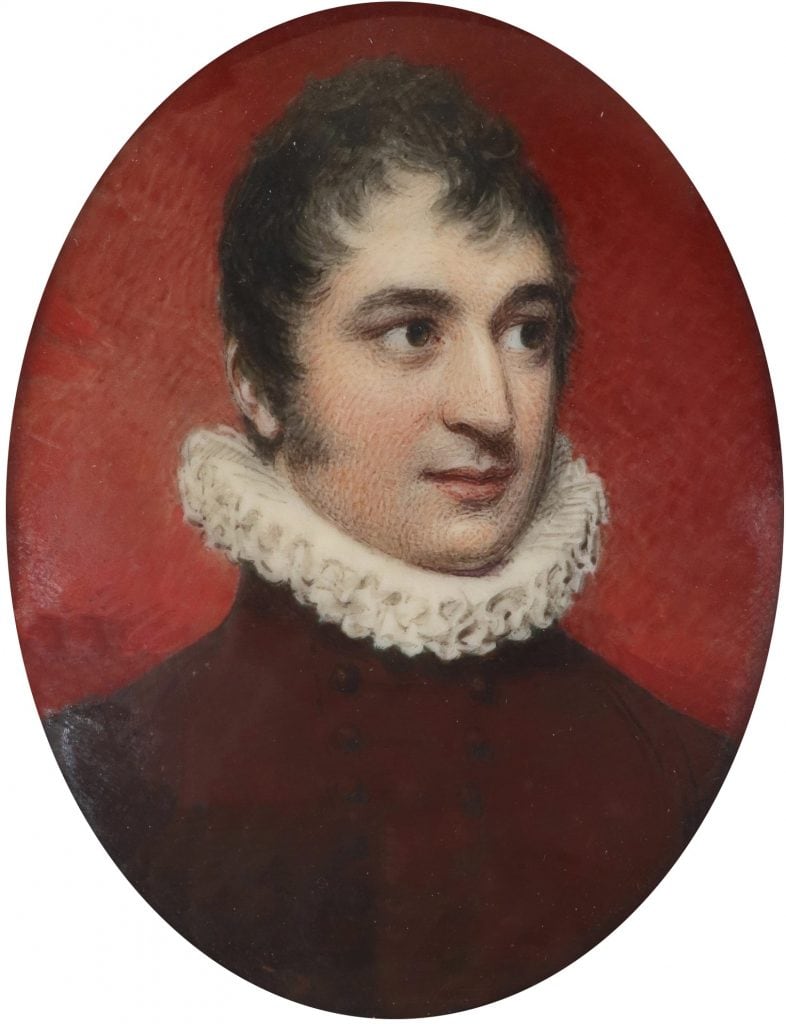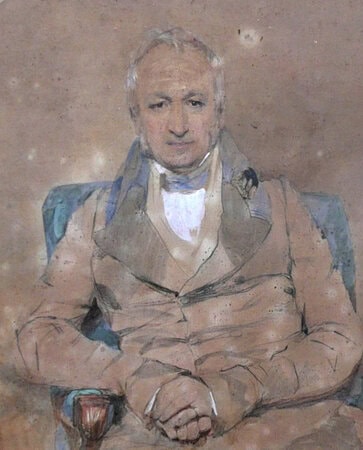With its elaborate outfit and dark red background, this miniature is rather a surprise within William Wood’s catalogue. His work is often characterised by understatement. Subjects are commonly set before a subdued sky of whites and greys with touches of blue. His men tend to wear dark jackets of either navy or brown, and his women white, high-waisted, empire line dresses. There are gentlemen in military uniform, certainly, but rarely an outfit so overtly theatrical as this. Taking the clothes and the deep red curtain together, my first thought was that the subject must be an actor dressed for his best-known Shakespearean role, but the truth is more prosaic.
The subject is John Dean Paul (1776-1852), a London banker, resident on the Strand, and 25 years old when he sat for Wood. Wood records this commission in some detail as ‘5863 – Mr J.D. Paul, of the Strand; Banker’.(a) Paul has chosen to be depicted in Vandyke dress, costume attire inspired by the paintings of seventeenth-century Flemish artist, Anthony Van Dyck. Masquerade balls and fancy-dress parties were perennial high points on the Georgian social calendar, and Vandyke outfits, with their double lace ruffs, puffed sleeves, split tunics and finely embroidered detailing, offered men the chance to wear something immaculate and spectacular. King George IV himself was a personal enthusiast.(b)
Wood’s records give us five dates in total. He began it on July 26th, 1801, delivered it (unfinished) on August 4th that year, completed it on March 12th, 1802 and then delivered it, a second time, four days later. It was then exhibited at the Royal Academy in 1802.
A glimpse of Napoleon
The spring of 1802 marked the opening of a brief window, lasting barely a year as it turned out, when Britain was not at war with France. Thirteen years had passed since the start of the French Revolution in 1789 and nine years since the execution of the French royal family at the Place de la Concorde. Britain had been at war with its nearest neighbour since February 1793. The country was gripped with fear as Bonaparte’s forces swept through continental Europe and lived with the dread of an invasion. The signing of the Treaty of Amiens in March 1802 promised to bring this turmoil to an end.
In August 1802, Paul and a small group of friends decided to visit Paris, a city for so long out of bounds. Paul kept a diary, which he published on his return as a guide for the benefit of travellers considering a similar journey.(c) As a banker with a reassuringly keen eye on the finances, one of his preoccupations was to help travellers to budget realistically and to avoid being fleeced by unscrupulous Frenchmen for travel, meals and accommodation, something he makes very clear was common in Paris. Curiously, Paul had married Frances Simpson in 1799, and their second child, John Jr, had been born in May 1802, just two months before the trip to Paris. There is no mention in his travel journal of whether his wife was one of the three women who travelled with his party, but certainly no children joined them.
The group make the most of what the city has to offer. The high point, at least for a modern reader, is their trip to the opera. Mid-way through the performance, they realise that Napoleon’s second in command, Cambacérès, is in the theatre with them, and they start to wonder whether Napoleon himself might also be at a show that evening. Learning from a guard that he is indeed close by, at the Theatre Francois, they immediately ditch their show and head over, hoping for a glimpse. They are just in time, arriving shortly before Napoleon makes his exit, and Paul is able to report on this impressive bit of Georgian star-spotting:
‘He was seated in a very handsome balcony box near the stage, a good deal surrounded, and accompanied by other generals, and Madame Bonaparte, with some other ladies. As soon as the play was ended… he came forward to the front of the box and gracefully took his leave, making three respectful bows to the audience, and apparently much pleased with the applause he met with.
He is, as everyone has heard, a little man, but with an intelligent spirited countenance, and an eye that speaks an uncommon mind; he wears his lank hair out of powder, very short, and was dressed in a blue coat most richly embroidered. I looked at him with much curiosity, as a man whom concurring circumstances, together with his own uncommon talents, have raised from a state of insignificance to the possession of the largest share of power of any individual in the civilized world.’
The Peace of Amiens ended in May 1803, just nine months after Paul’s return, as Europe embarked on another brutal decade of war. His journal of his exciting voyage to Paris, together with William Wood’s playful Vandyke miniature, capture Paul as a young man, before too many adult responsibilities lay their heavy hand on his shoulder. At least five more children with Frances followed his return, and two more marriages. Paul was created a baronet in 1821 and became partner in one of the country’s oldest banks in 1828, where his son, John Jr, joined him. He continued to write, draw and paint in his spare time, and between them, father and son wrote and illustrated ‘The Country Doctor’s Horse: A Tale in Verse’ in 1847.(d)
John Dean Paul died in 1852. His bank met its demise just three years later when his son, John Jr and fellow partners became embroiled in a high-profile Victorian financial scandal, which led to the bank’s collapse and a conviction of fraud for each of the partners.(e)
A faded portrait by an unknown artist, this time on paper, shows John Dean Paul in later life. His hair is white, his tan jacket is more crumpled and less flamboyant, but the dark eyes, high hair line and facial features are recognisable from Wood’s youthful depiction of 1802.(f)
==
Selected sources:
a. All fee book references relate to the V&A. Memorandum of miniatures painted and finished by William Wood, vols. 1-3 (MSL/1944/433-435)
b. ‘George IV, Prince of Wales, and the Habits of the Masquerade’ (Meg Kobza, 2018). Accessed via https://georgianpapers.com/
c. John Dean Paul, Journal of a party of pleasure to Paris in the month of August, 1802: by which any person intending to take such a journey may form an accurate idea of the expence that would attend it, and the amusement he would probably receive: together with thirteen views from nature, illustrative of French scenery (London: T. Cadell, Jun. & W. Davies, 1802)
d. John Dean Paul, The Country Doctor’s Horse: A Tale in Verse, 1847, (London, obl. fol.) 31pp
e. The Queenslander, 19 Dec 1868. Article “The Later Sir John Dean Paul”
f. Ancestry, originally shared by Richard Lane on 18 Mar 2019.

